|
navigation
consulting
services
training
services
specials
reading
material
resources
|
The solution actually adopted (not necessarily the best nor the only one) was based on healthy principles of Lean Manufacturing/Flow Production (more ») and Cell Manufacturing (more »).
The basic targets were:
- drastic reduction of stock, especially finished product
- reduction of redundant manpower
- rationalisation of layout
- "pull" production, as much as possible
- maintaining or bettering the present "responsiveness" to customers' expectations (delivery time)
- elimination of the present quality problems (wrong deliveries)
Initial studies were carried out. All "cycle times" were accurately measured.
A few conclusions came out crisp and clear:
- The sum of the overall value adding time (time during which value was actually added to the product) correspondent to one year of production (approx. 2.000.000 sachets packaged and cartonised) was considerably less than one-year normal working time of two labourers.
Like to say that two labourers, working only to "add value", would very well cope with the present level of demanded production.
This gave immediately an idea of the presently "wasted" labour.
It was also easily concluded that the present waste was hiding in the handling, double-handling, moving, storing, parking, searching, etc. of WIP (work in progress) and finished product. This was caused by the present batch production method totally push in its style.
- Therefore, by switching over to a different method (pull and flow) most probably the present waste would be exposed to light and eliminated.
However, it was clear that a pull method would be easy to implement, starting from downstream, for the entire packaging process - but with the exception of the Sachets filling operations.
Due to the complexity of changing over too often from one fragrance filling to another, it was concluded that the optimal method of Sachets filling would have still to be push in style, based on batches equivalent at least to one full drum of granules per fragrance (4000 sachets of a fragrance - approx. half day production in one machine).
- In any case, though maintaining a "batch" sachets filling method, it was concluded that one labourer would be capable of producing with one machine 8000 filled sachets/day (2 full drums), equivalent to 1.936.000 sachets per year (8000 sachets per day x 22 days/month x 11 months/year), without overtime.
- It was also concluded that another labourer would have ample time to package all finished products, provided her activities would be mainly value adding in their nature.
This would imply to cut to nil all current wasteful activities (as described above).
The only answer was to organise working areas dedicated to the entire packaging process, starting from Full Sachets and Packaging Materials, and ending up, in one cycle, with finished products.
The entire process was re-engineered, and the factory layout re-designed accordingly.
It was easily concluded that it would be worthwhile to invest in some extra equipment (simple, home-made-style packaging and delivery facilities), bearing in mind the corresponding labour savings.
There was a snag, though. Since the target was to manage the entire operations with the 2 permanently employed labourers, it was very important to make both of them multi-skill/multi-function and fully interchangeable (for a number of good reasons).
So both of them had to be gradually re-trained in the new style operations (as fully described below), and both of them were deeply involved in the re-engineering process.
The final outcome (gradually implemented in about 4 months), was as follows:
- Labour organisation. The two labourers were exchanging roles on a weekly basis: during a certain week the one would only do Sachets filling operating one machine, while the other labourer would do all the rest (final packaging of all products - taking orders - preparing orders - attending to products delivery - factory logistics and cleaning - and helping, occasionally, with Sachets filling at the second machine) - during the following week they would simply exchange their roles.
This was done in order to mitigate the boredom associated with routine Sachets filling work.
- Sachets Filling. This was done on a pure push basis. The simple method was to maintain a predetermined Full Sachets stock level, based on past sales statistics.
- Orders Taking. This was done by the "Clerk" of the week (the labourer in charge of packaging, orders taking, etc. for that week).
Since the bulk of her time would be spent in the factory - rather than in the office - she was provided with a wireless phone that she could carry around in the factory. So that, wherever she was, she could easily take orders and record them in a simple Internal Order form.
- Orders Processing. This was also done by the "Clerk" of the week. Processing was done through an extremely simple computer program (based on a spreadsheet):
- All orders received between 08:00 and 12:00 would be processed just after lunch time (12:00 - 12:30), i.e. in the afternoon.
- All orders received between 12:30 and 16:30 would be processed first thing next day.
- The Clerk would input all orders details in the spreadsheet program. A progressive Internal Order Number would be assigned uniquely to each order.
- The computerised program would then automatically print all self-adhesive labels to be stuck onto each Carton belonging to that order. The label would indicate: Internal Order number - Delivery Note number - Customer Name and Full Address - Customer Order Number (if any) - Carton content (i.e. 1 assorted Display Box - 50 sachets Lavender - etc.) - Carton x of y.
- The program would also print automatically the Delivery Note (2 copies) associated with each Order.
- The program would also print a Delivery Bin Sticker (see below)
- Orders Preparation. After processing a batch of orders, the Clerk would immediately get ready for final packaging of those orders. Delivery Bins and a Delivery Counter were essential items of the re-engineering exercise.
The Clerk would get a number of plastic Delivery Bins equivalent to the number of orders to be packaged. She would stick the Delivery Bin Sticker onto each Bin. Insert in the Bin the 2 copies of the Delivery Note. And bring each Order Bin to the special Packaging Cell dedicated to that type of product (see below).
- Then the Clerk would become a Packaging Labourer and start packaging each order.
- Packaging would be carried out in dedicated Packaging Cells. There were two for Display Boxes, one for Cartons of Blister Packs, and one for Cartons of 50/200 Sachets.
- Packaging of Display Boxes.
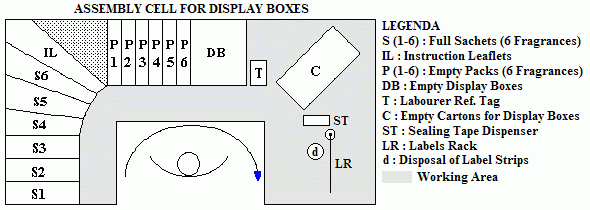 The Display Boxes Packaging Cell contains all what is required to assemble and cartonise Display Boxes (with assorted-fragrances or one-fragrance packs): full sachets - empty packs - instruction leaflets - empty display boxes, etc. The Display Boxes Packaging Cell contains all what is required to assemble and cartonise Display Boxes (with assorted-fragrances or one-fragrance packs): full sachets - empty packs - instruction leaflets - empty display boxes, etc.
The labourer works clockwise. First she opens up a flat, empty Display Box - then she starts packaging packs, and inserts them straight away in the Display Box - once the Display Box is full, she closes it, and she cartonises it straight away - the carton is sealed with tape (ergonomically positioned in a dispenser) - then the Carton Label is stuck onto it - the Carton goes immediately into the Delivery Bin.
This means that all activities carried out by the Labourer are value adding activities. Practically (except some micro in-activities or some positioning micro-activities) there is no wasted time.
The Cell output is a finished product, ready to be dispatched.
The Cell layout is very rational: all "components" are stocked in logical sequence, so that work is a continuous flow of value adding movements.
The "containers" of all components are slightly inclined forward, so that items are easier to reach and grab (gravity does the trick).
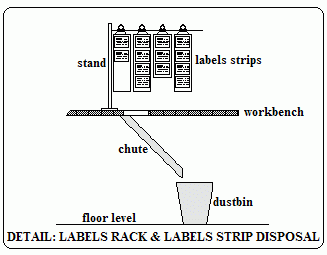 It is interesting to note the system that was used to "park" Cartons Labels belonging to the same customer order. Since Labels were printed in strips (one strip per order - therefore, a minimum of two labels in a strip), a "rack" was made and placed on a stand in the Cell workbench to hang the various strips, so that each order to be processed in the same Cell would not be mixed up. It is interesting to note the system that was used to "park" Cartons Labels belonging to the same customer order. Since Labels were printed in strips (one strip per order - therefore, a minimum of two labels in a strip), a "rack" was made and placed on a stand in the Cell workbench to hang the various strips, so that each order to be processed in the same Cell would not be mixed up.
Strips also made easier and faster picking up and sticking labels onto cartons.
Empty strips ( = order completed) would be disposed of through a disposal hole in the workbench, and via a chute they would fall straight into a dustbin.
The Cell style of packaging improved drastically the overall Cycle Time. The "before" Cycle Time was: approx. 5 seconds per pack = 120 seconds for 24 packs - between 25 ad 35 seconds to fill a Display Box (depending: one fragrance or assorted fragrances) - and approx. 20 seconds to cartonise the Display Box. In total, it was between 165 and 175 seconds for the entire operation (carried out in "fragments" and at different times).
The "after" Cycle Time showed constant improvement over time (until the Labourers familiarised with the Cell style). Eventually, it stabilised at just less than 2 minutes, both for assorted-fragrances and one-fragrance Display Boxes, with a net improvement of 35% (typical, when switching over from Batch to Flow/Cell).
- Preparation for Delivery
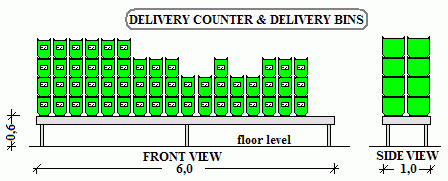 When each customer order was completed, the Clerk/Packaging Labourer would place immediately the corresponding Delivery Bin onto the Delivery Counter before proceeding with packaging the next customer order. When each customer order was completed, the Clerk/Packaging Labourer would place immediately the corresponding Delivery Bin onto the Delivery Counter before proceeding with packaging the next customer order.
This was a rule, which worked out extremely well: no more mixing-up of orders took place any longer.
So, the investment in a lot of plastic Delivery Bins was fully justified. They were stackable onto each other, and capable of containing a "typical" Customer Order. In those few cases in which a Bin was not adequate to contain a full order, two or even 3 Bins would be used, all carrying the same Internal Order Number stickers - the computerised program was in fact designed in such a way that it would print as many Delivery Bins Sticker as necessary to cater for that volume order.
All Bins would be placed rationally on the Delivery Counter, fully ready for despatching.
- Packaging of Cartons of Blister Packs.
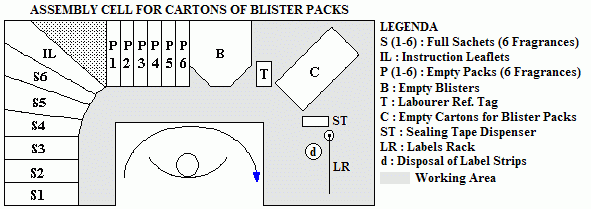 With very similar criteria to those used for the Display Boxes Packaging Cells, also a dedicated Cell for Packaging of Cartons of Blister Packs was home-made constructed. With very similar criteria to those used for the Display Boxes Packaging Cells, also a dedicated Cell for Packaging of Cartons of Blister Packs was home-made constructed.
The operating principle was identical, with the exception that Full Packs would be inserted into Blisters, and Full Blisters into Cartons.
The rationalisation brought more distinct advantages in this case: the overall Cycle Time improved (decreased) by a whopping 45%.
Delivery Bins containing Full Cartons of Blister Packs would be brought straight away to the Delivery Counter, exactly as in the case of Display Boxes.
- Packaging of Cartons of 50/200 Sachets.
With very similar criteria an Assembly Cell (one only) was made also for this product, and dedicated to it.
The improvement in the overall Cycle Time was not as exciting as for Display Boxes and Blister Packs - still, a solid 20% improvement was achieved and maintained.
The main benefit was in the rationale of the processing style, and in the total elimination of orders mix-up and misplacements/mis-deliveries.
- New Factory Layout.
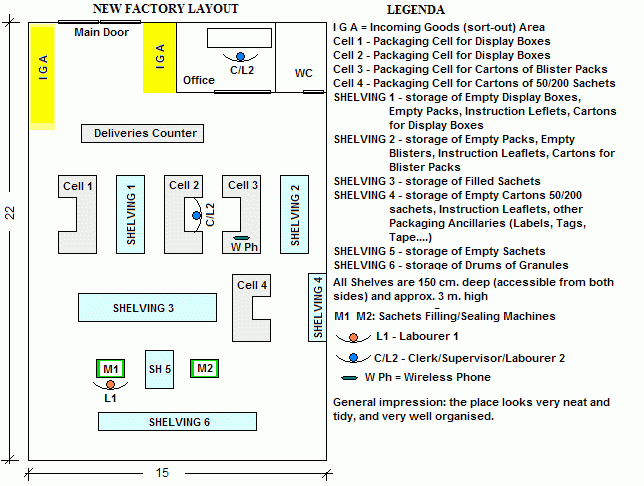 The new Layout was rather different from the previous one. The new Layout was rather different from the previous one.
There is a well demarcated "Goods Incoming Area", in which all incoming goods (local and ex-import) are temporarily parked for necessary controls before being placed on their storage areas.
The Delivery Counter is rationally and strategically positioned.
The 2 Display Boxes Packaging Cells, as well as the Blister Packs Packaging Cell and Cartons of Sachets Packaging Cell are strategically positioned close to the shelves that contain their respective packaging materials. This makes refilling of Cells' stock easy and fast.
Shelving overall volume has drastically decreased, due to more frequent deliveries of local components and due mainly to the elimination of the bulk of WIP (work in progress). The only permanent WIP is now represented by Full Sachets, stored in Shelving 3.
Shelves have been rationalised, not only in position but also in size. They have been studied in order to contain the "peak" of stock (just after receiving typical deliveries, both local and ex-import), with a margin factor of 50% to cater for a few years expansion.
All Shelves (except Shelving 4) are so conceived as to allow easily the implementation of the FIFO (first in - first out) principle of stock rotation (see also Materials Flow - below).
In practice, all Materials (or Products' components) are now stored directly in the processing area or very next to it (like in the case of Drums of Granules). This minimise any handling involved, and rationalises the re-stocking of processing areas.
The working location of the two Labourers is also evident.
- Materials Flow.
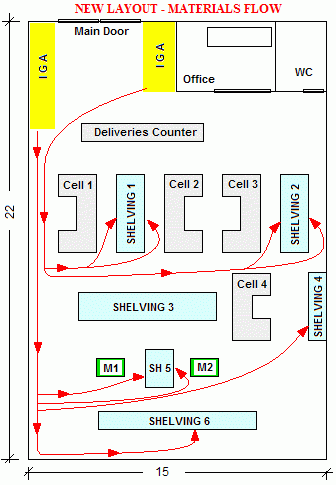 It's easy to see how easier and faster is stocking of shelves in the new layout. It's easy to see how easier and faster is stocking of shelves in the new layout.
The floor is now free and access to the various storage areas is facilitated. Restocking following the FIFO principles is facilitated by the front/back access of the concerned shelves.
Regaining the ownership of the factory floor was one core point in the re-engineering exercise.
The simple target was: "nothing standing on the floor, except fixtures".
This brought a well distinct advantage and created an easy to move-around factory.
- Processing Flow.
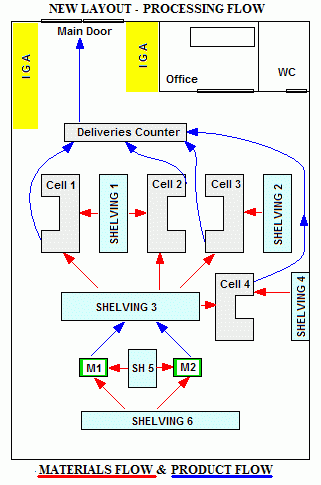 The overall advantages can easily be seen in the Processing Flow diagram. The overall advantages can easily be seen in the Processing Flow diagram.
Materials movements are minimised: from shelving areas they can be brought to processing areas in a ziff.
Also Finished Products movements are minimised, to the extent that it is justified to bring a Delivery Bin to the Delivery Counter straight away after Order packaging (to prevent any possible hick-up or mix-up).
The final result is a clean, neat, organised, flowing Factory, with very minimal residual waste.
- Product Dispatching.
At collection times (09:00 and 14:00) the Clerk/Packaging Labourer just stops whatever she is doing and takes care of the delivery process.
This is very simple and streamlined: the Delivery Company driver just takes the full lot of Delivery Bins ready to be dispatched and loads them up in the delivery truck.
Each Delivery Bin contains the associated Delivery Note (in duplicate), one to be signed by Customer and returned after delivery.
Empty Delivery Bins are returned to the factory after delivery. So, there is always a lot of Delivery Bins "floating" between Factory and Customers. The Delivery Company is fully responsible for keeping the Delivery Bins in good conditions, and returning them to the Factory once their content is delivered.
A simple form that takes care of assessing the balance of "out-of-the-factory" Delivery Bins at any moment in time is filled jointly by the Delivery Driver and the Clerk and signed by both.
FINAL CONSIDERATIONS
Some final considerations on this solution:
- Sachets Filling Machines. The alert reader might be puzzled by the fact that only one machine ended up being utilised for sachets filling.
Well, the "before" system, fully "push" and rather disorganised, relied on large stocks of all components, including sachets. The two machines were utilised full-time, but in a rather chaotic way, and with frequent interruptions and disruptions (typical, in spite of excessive filled sachets' stock, was the case of not having enough filled sachets of a certain fragrance - and too many of the others) - disruptions were generated by the necessity of producing some urgent stock of the lacking fragrance, "changing-over" the machine in a hurry to be ready for that fragrance. Obviously, this was very messy.
In the "after", better organised system, production became more balanced, easily controlled, and fully streamlined. The net conclusion was that one machine was practically sufficient for the present needs.
However, the second machine came handy for several reasons: maintenance - reduced cleaning of hoppers (for fragrance change) - ready to be used by a future, 3rd worker (in case of increased sales) - and, most of all, it could be used by the Clerk/Packaging Labourer in her spare time (yes, she had some spare time, see below).
In fact, thanks to the flexibility and multi-function abilities of the Clerk (of the week), it was possible to produce the necessary stock of filled sachets, and a bit extra (to be safe).
This formula was fine for another 18 months. Then, due to increased sales, a part-time casual labourer was utilised again at the second machine (eventually, after 3 years, a full-time labourer was employed - with functions/duties identical to the other two).
- The mixed system "push/pull" had a "coupling point", represented by the WIP of filled sachets.
This was a handy compromise. It would have been foolish to try to go for a full "pull" system: this would have required 6 sachets filling/sealing machines, extra space, a totally different organisation, and its benefits would have been very arguable.
Such a compromise is normal in many "lean" productions concerns.
- Production Scheduling. This resulted in an extremely simple system: a "re-stocking/replenishing" method for production of filled sachets, and no scheduling at all for the final packaging.
The final packaging was simply "pulled" by customers' orders.
The "after" system was extremely responsive: not only the "before" D-Time (customer expected Delivery Time) was maintained, but it was also improved: in the case of very urgent orders the Clerk/Packaging Labourer was able to dispatch urgent orders the same day they were received.
- A major improvement, allowed by the new layout (and, generally, by the new system), was the FIFO method of stock rotation.
Although not vital, as the particular type of product had a very long shelf life, this resulted in a better management and monitoring of all stocks, with special regard to the stock of granules in drums and of the filled sachets.
- The alert reader might also be puzzled by the fact that one of the two workers, the Clerk/Packager, had sufficient time to cope with all her duties and tasks.
At the present rate of sales, actually she had ample time, granted by the high productivity associated with the "flow/pull" system. But, let's do some calculations:
-She receives and process customers orders. This was taking, at most, 1 hr/day.
-She deals with the Delivery Company (0,5 hr/day).
-She refills all Cells with components and does some cleaning. Restocking Cells (done every second or third day) was taking an average of 15 minutes/day - cleaning and general housekeeping was a max. of 15 minutes/day. All together, average, 0,5 hr/day.
-Considering the half hour lunch time, there are 6 hrs net left for packaging (and sachets filling, not every day).
-Now: at a sales rate of 2.000.000 sachets/year, 75% of which are sold as Display Boxes, there are 0,75x2.000.000/4/24 = 15.625 Display Boxes to be packaged in a year. Over 11 months (the factory shuts down for 1 month every year), there are 1420 Display Boxes to be packaged every month. Considering 22 working days in a month, this results in an average of 65 Display Boxes per day to be packaged. At an effective cycle-time of 2 minutes per Display Box, this takes just above 2 hours, every day. Considering also the time required for Cell preparation (mainly: bringing all labels and stickers and organising the Cell) - and product removal from the Cell (destination: Delivery Counter) - as well as loss of focus due to possible customers orders phoned through while packaging - we can conservatively say that 2,5 hrs/day are required to produce the necessary volume of Display Boxes.
-Since Display Boxes are the bulk of the sales (75%), it is easy to understand that the Clerk/Packager has 3,5 hrs/day left to package the balance (25%) of the products, and to fill sachets at the 2nd machine. This time is much more than enough!!
-Obviously, there were "relaxed" days and "hectic" days. During "relaxed", easy days, the Clerk/Packager would produce extra stock of filled sachets - so that, during "hectic" days, the other worker would help her with packaging tasks. This was an excellent, self-regulated system, capable of smoothing any ripple.
-Moreover, there were other sporadic tasks to be executed: for instance, receiving local materials and imported stock, checking and positioning them on their respective shelves. Once again, the system was "self-regulating": due to the presence of filled sachets WIP, the second worker would be able to act as a "joker" at any moment in time. Any lost production of filled sachets would then be compensated by the Clerk/Packager during "easy, relaxed" days.
- Hence the need for the second Display Boxes Packaging Cell.
This was introduced not only to prepare for future expansion, but also to allow simultaneous packaging of Display Boxes by the two labourers, should the "peak" come (and it was coming, from time to time....)!
In conclusion, the (very small) investment for the second Cell was very well justified.
- A number of initiatives contributed to the "after", astonishing results: the "Flow/Cell/Pull" style - the rationalisation of the Factory Layout - a revamped stock management and shelving system - the overall order taking and processing method - the rationalisation of Product Delivery through a Delivery Counter and Delivery Bins - and, most of all, multi-skill/multi-functional labourers!
- Yes, the human factor was the ultimate winner.
The two permanently employed workers understood (through intensive, informal training) not only the challenge associated with the new style operations but also the benefits.
And grabbed both of them. And made things happen.
They participated intensively in the re-engineering process, and came up with many ideas (to mention just one, the wireless phone idea came from one of them!). They went into the nitty-gritty's of re-engineering the entire Factory with enthusiasm and deep involvement, enjoying very much the switch-over process.
Eventually, they were extremely satisfied with the new set-up, and accepted the challenge even further introducing more improvement details.
Their "empowerment" level became very high. Eventually, the new owner was coming to the Factory only sporadically, dedicating his time more and more to marketing and promotion. Sales increased steadily, also because prices were kept steady for long time (increased competitiveness introduced by increased productivity and lower costs). Expansion came as expected, at a better rate than expected.
- Within 1,5 years another worker (one the previous casual labourers) was employed part-time and after another year and a half full-time.
Within another year another of the previous casual workers was also employed full-time.
Which leads to the conclusion: a healthy productive system generates wealth, competitiveness and guarantees a better future.
Read the case again - click here
Would you like to comment on this tutorial?
Would you like to suggest another solution for this case?
Your comments and feed-back are most welcome - please contact Carlo Scodanibbio.
|

